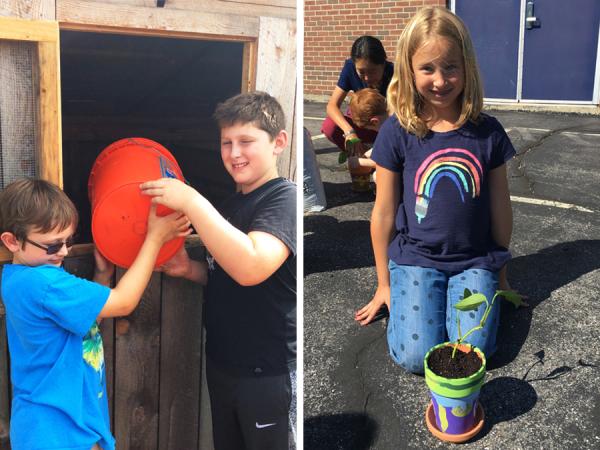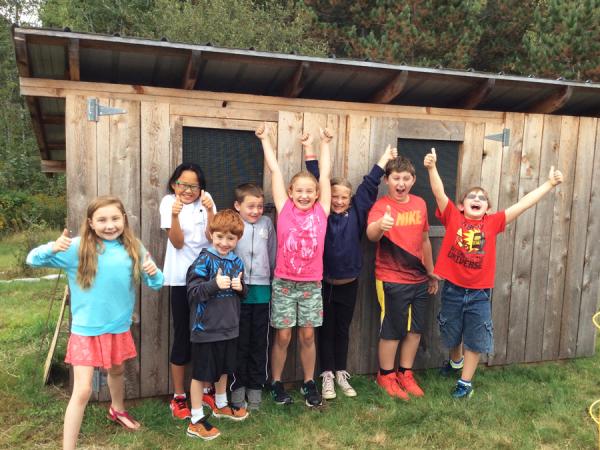One Rural School’s Journey to Becoming an EFS School
Check out this inspiring story of how a school found purpose and vision in the idea of sustainability. Walter Huston, of Perkins Academy, is an alum of our EFS Leadership Academy. Many of his staff have participated in our annual Summer Institute on Education for Sustainability. We're so excited to see how our work with educators here at the Farm ripples out through schools and communities to effect real change.
—Jen Cirillo, Director of Professional Development
Three years ago, as a first-year principal of John D. Perkins, Sr. Academy of Marlow, a rural K-6 school in picturesque Marlow, New Hampshire (pop. 750), I was tasked with forming a committee to create a mission statement and provide the school with a clear focus and purpose. The school’s enrollment was quickly declining. A few years earlier, the town lost its only store and gas station, leaving not much to attract new families. The school board felt that if the school had a clear focus, it would help alleviate the problem.
Due to the school’s location on a beautiful 10-acre campus, many community members felt the emphasis should be on environmental education, but the staff were concerned that they lacked the background to promote such a focus. After examining what the committee valued, believed, and hoped for concerning the education of its children, a mission statement was developed, focusing on caring for others, engaging in academic pursuits, and interacting with the local community and environment. We brainstormed what each element would look like in an elementary school, but we had no idea how to go from a dream to reality.
In the weeks that followed, I researched a variety of innovative schools that matched what we wanted to do and found the Sustainability Academy at Lawrence Barnes, a K-5 magnet school located in Burlington, Vermont. The Academy promoted many of the elements we wanted to incorporate into our program — although at the time, the term "Education for Sustainability" meant nothing to the staff or to me.
After visiting the Sustainability Academy, we were connected with the Sustainable Schools Project at Shelburne Farms in Shelburne, Vermont. Through their professional development and guidance, the more we learned about Education for Sustainability. (EfS), the more we realized it was exactly what we wanted for our school, and understood how the mission statement we’d created aligned nicely with the lens of sustainability. EfS is not just about the environment — it is about teaching students how to meet the needs of the present without compromising the ability of future generations to meet their own needs, and teaching them how to live peacefully and respectfully with those around them. Understanding those Big Ideas pushed the school forward on a journey we could never have imagined.The first step was changing the name of the school. It was originally called Perkins Elementary School after John D. Perkins, Sr., a local farmer whose family donated the land for the school after his death in the early 1970s. Wanting to let the surrounding communities know we were doing something different, we changed the "elementary school" to "Academy" and then added the "of Marlow" part to remind everyone we are part of Marlow — and they are part of us. Reflecting upon it later, we realized that the new name aligned itself with our new mission statement. The John D. Perkins, Sr. part was a reminder of how one man cared for others by donating the land; the engagement in academic pursuits is found in the word "Academy"; and "of Marlow" reminds us how we interact with our community and environment.
The next step was rewriting the school’s curriculum to incorporate the Big Ideas of sustainability. Over the past two years, the staff has created six school-wide themes to be taught over a two-year period integrating the Next Generation Science Standards and the Common Core State Standards for ELA and Math. It continues to be organic as teachers reflect, rewrite, and refine the units each time they work with them.
The teachers began finding ways the students could interact with the environment and the community, using the grounds as an additional classroom space integrating environmental exploration into the curriculum. In addition, they created more opportunities for the students to interact and serve the community, from preparing the cemetery for Memorial Day to sending Valentines to every household in the town. The students also hike, snowshoe, and canoe with a local program call Kroka.
Our journey is far from over. We continue to learn and add more elements into the school program as we go along. We have a school gardening program, built a compost center, and recycle as much as possible. We follow the Responsive Classroom model throughout the school. We try to teach our community whenever possible about EfS; so far, the results are positive, and new families are moving into town. Marlow values its small school and supports it in so many ways. They know we love them, and they love us back — living out the tenets of EfS.Walter Huston (whuston@sau29.org) has been an educator for almost thirty years. During that time, he has worked with elementary students from kindergarten through grade 6 in rural, urban, and suburban settings throughout Massachusetts and New Hampshire. Huston earned a BS degree from Gordon College in Elementary Education/Middle School Education. He earned a Master’s degree in Special Education from Lesley University and is now completing his doctorate studies at New England College where his research is examining the relationship between leadership and education for sustainability. He is the principal of the John D. Perkins, Sr. Academy of Marlow in Marlow, New Hampshire.
This article was originally published in the Fall 2017 Green Schools Catalyst Quarterly. The Green Schools National Network, a 501c3 non-profit organization founded in 2008, works with educators, government and non-governmental organizations and agencies, as well as private partners to create broad-based initiatives and successful strategies aimed at fostering healthy, sustainable K-12 schools across the United States. Founded by principals, superintendents, and teachers, GSNN is devoted to accelerating student achievement through the implementation of green, healthy and sustainable practices as outlined in our GreenPrint® for Green, Healthy, and Sustainable Schools. Images courtesy of Perkins Academy.

